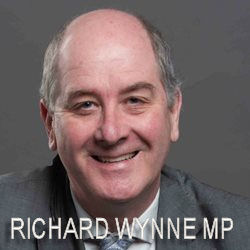 Victoria’s Planning Minister, Richard Wynne recently dropped a bombshell on thousands of apartment owners whose buildings are covered in flammable cladding.New loan laws likely to be passed by Parliament have been billed as a kindly gesture to help owners of apartments covered in the flammable cladding to ffund the rectification costs. This news might seem a worthy initiative, except that the most iniquitous elements in this scandalous swindle are unspecified. Principally, Wynne’s decree provides that owners who bear no blame for this combustible catastrophe are to be burdened with a debt that could run into billions of dollars. [Article first published at https://www.thefifthestate.com.au/innovation/materials/apartment-owners-dodgy-cladding/ on 13 September 2018.]
Victoria’s Planning Minister, Richard Wynne recently dropped a bombshell on thousands of apartment owners whose buildings are covered in flammable cladding.New loan laws likely to be passed by Parliament have been billed as a kindly gesture to help owners of apartments covered in the flammable cladding to ffund the rectification costs. This news might seem a worthy initiative, except that the most iniquitous elements in this scandalous swindle are unspecified. Principally, Wynne’s decree provides that owners who bear no blame for this combustible catastrophe are to be burdened with a debt that could run into billions of dollars. [Article first published at https://www.thefifthestate.com.au/innovation/materials/apartment-owners-dodgy-cladding/ on 13 September 2018.]

Why are building owners forced to foot the bill?
The answer to this question is very simple. In line with past policy, the government has decided to protect rogue builders and transfer responsibility to blameless owners.
As always, there has been superlative spin, secrecy and incredible storytelling. Unearthing the truth required a long, complicated and tortuous path to find what has been hidden – that consumers remain wholly unprotected.
The Burning Question
After years of dodging the question of who would be forced to pay to rectify the potentially lethal cladding bill, Wynne has waved through an answer of sorts, in the form of his new building amendment. But it is double-speak.

Wynne’s resolution does not include the full facts, nor the horrendous implications. In addition, this new legislation has been made more difficult to comprehend because of the missing link between this reform and his earlier consumer protection laws passed in 2016.
You need to look at what underpins it, and that can take many laborious hours. Only once you decode the cryptic core of the amalgam do you discover the deceitful laws that have been secretively enacted.
Fundamentally, the Andrews’ government has shifted legal liability from delinquent builders to owners. For Wynne’s winners an unsurprising get-out-of-gaol windfall. For owners, another titanic bombshell.
Part 1 2015: First building bite
Here’s what you need to know.
While the public might have thought that the government was taking its time to deliberate the enormity of the question about who pays for the replacement of dangerous flammable cladding, its plan was discreetly put into action in early 2015. Nonsensically, it was peddled as a consumer protection strategy.
Minister Wynne, and all his helpful advisors, needed time. The scope of works for this serpentine strategy had to be schematised.
Paradoxically, this decision to sentence consumers was selected as the strategic keystone four years ago. The spin doctors suppressed the news.
This was mixed in with Wynne’s inaccurate statements. For example, after the tragic Grenfell towering inferno in June 2017 where he told The Age a fire of the magnitude of the Grenfell Tower blaze would “not happen here in Victoria… or Australia, in fact. Because we have the strongest building codes of any first world country.”
Now to the first step in the narrative: Wynne’s Building Legislation Amendment (Consumer Protection) Bill tabled in 2015. Just like the current bill, the draft of this legislation was denied to the public until it slipped into parliament to be passed effortlessly in early 2016.
Consumers and activists made repeated unsuccessful attempts to access and read the draft bill. By the time the news became public, it was too late.
Naturally this triggered suspicion. Why all the secrecy and what was to hide?
Well, Wynne had agreed to insert an explosive Clause 37B into the Building Legislation Amendment (Consumer Protection) Bill 2015. It was designed to deprive the Victorian Building Authority (VBA) of its powers to order rectification works once owners had taken possession of a building. Additionally, Wynne removed other clauses to diminish the VBA’s broad powers to virtually nil.
Then, in October 2017, LU Simon Builders, who constructed the Lacrosse Tower (Australia’s only reported cladding fire in Melbourne in 2014) set out to test the VBAs powers. The builders mounted a legal challenge in the Supreme Court to stop the VBA ordering it to fix another six multi-storey towers which it had also constructed with the non-compliant cladding.
The Supreme Court’s judgment came on 22 December 2017. LU Simons lawyers found the helpful Clause 37B. It delivered a whopping win!
Part 2 2018: Second building amendment bite
Let’s examine Wynne’s current Building Amendment (Registration of Building Trades and Other Matters Bill 2018 which he slipped into the Legislative Assembly on 26 July 2018. Classified top secret, it was withheld from the public until 7 August 2018. This Bill amends the Building Act 1993 and the Local Government Act 1989. In the Assembly, Wynne summed up the biting intention of his Loans Scheme “to provide for agreements to rectify defective cladding on buildings and charges to fund the rectification”(Hansard).
Referring to Cladding Rectification Agreements (CRAs), Wynne omitted to mention loans, or to cite owners as the target group.
This shadowy oration ended on an optimistic note claiming the Scheme would, “create a pathway for people to follow if they have been asked to rectify non-compliant cladding.” (Hansard p2435)
This was sinful scheming. The people vaguely referred to in these laws are owners, unfairly designated as blameworthy by the government and bonded to the pay pathway. How could owners be the punished when it was builders and developers who ignored building regulations and installed highly dangerous cladding? For those conversant with the bizarre building rule book, this lunacy lies at its bedrock.
The minister postulated misinformation about people being asked to rectify when he, of all people, knows that he agreed to owners being ordered to rectify.
Wynne’s speechifying to the house on the entire bill was settled in a scanty 244 words, the charade over quicker than you could boil a kettle! Unquestioningly, the hot potato issue with its CRAs was the most momentous. Hence, Wynne shunned attention, depressed difficult questions and sidestepped ever so swiftly. Instantly the Loans Laws all wrapped up!
In relation to announcing this news, there was little fanfare and negligible media coverage. The minuscule media release Helping Remove Dangerous Cladding, purported, “This scheme is the first of its kind anywhere in the world and offers owners the cheapest and most efficient way of removing dangerous cladding from their buildings.”
There’s nothing praiseworthy about this “world first”. Fancy wishing to lead the pack in the race to the bottom in third world building and safety standards. Hardly heroic!
Wynne further enlightened that his Bill was about “making properties safe and compliant with building laws, these financing agreements allow cladding to be removed quickly, without affecting property prices.”
Here Wynne failed to state that “safe and compliant” buildings are now mandated as the owners’ obligation. As for his preposterous claim that property prices will not be affected, many industry experts have confirmed this is clearly in the realm of the ridiculous.
Blueprint for Blame
In 2015 the Consumer Protection Act was created. Significantly, in 2017 its Clause 37B secured the Supreme Court ruling to shore up the present bill, contiguous with the loans laws. The crucial link from 2015, fastening it to the loathsome loans in 2018, was wisely stowed away, restricted to seemingly minor other matters– presumably to discourage and deter public interest.
Thus, the delay was never about time to weigh up the consequences for consumers or the community. It was not about “safety”, or builders being “compliant with building laws”, or “helping” owners.
It was solely about buying time to delimit the legislation to achieve the planned objectives. From 2015 to 2018, under the façade of protecting consumers, officialdom’s strategy was pushed in progressive stages, each sliding seamlessly and silently to stitch up the swindle.
Wynne had to hold off on any announcements until the time was right. This required Wynne’s poker face, the block-out and the lockout of the real stakeholders, and dogged determination to hold steadfast under pressure to pull it off.
With the full deck of cards, all our money – and under the direction of the beneficiaries – once the hand was laid down and the trump played, it was an “open misere’, an unbeatable winning hand. In reality, the blueprint for blame was drawn long ago, constructed to guarantee that the intended victims were clueless, utterly defenceless and unable to prevent impending disaster.
Loans Laws: Cladding Rectification Agreements (CRAs)
In a nutshell, the Act and attending Explanatory Memorandum specify the purpose of Cladding Rectification Agreements (CRAs) as expediting a tripartite agreement between owners (or owners’ corporations with 75 per cent of owners to consent), a lending body and the council to “provide a mechanism to rectify non-compliant cladding” by “facilitating the provision of funds”.
These funds are demonstrably loans, but in this legislative arrangement the English language definition is adjusted. No longer a mortgage, although referred to as money loaned in Clause 79 of the Explanatory Memorandum, this debt has been ingeniously dubbed a service charge. It seems there are no limits to innovative reform genius.
To consider the most significant corrupted characteristics.
First, councils are the pivotal players. They may, or may not, decide to sign up for this Scheme. There is a carrot for councils however – the charge of an administration fee.
Second, because they have no alternatives, this deal will propel financially able owners to secure a loan “with prohibitive costs”. Selling is not an option.
“Losing up to 90 per cent of the value of a property would spell financial doom for home owners and investors alike”.
Third, and self-evidently, it depends on whether owners can afford a loan. Notably, in recent weeks, some owners who have received orders to rectify (without knowing of the loans scheme) have declared on radio that their circumstances would not allow them to take on any more financial debt. So what happens to them?
Ultimately, as controlled consumers, their choices are limited. Take a loan or liquidate and lose everything. Not a choice. So distraught owners, up against the wall, will try to ward off the wolf and opt to repay the loan with interest “in equal instalments” to councils over 10 years.
There are a number of specific conditions pertaining to CRAs. For example, before signing up, owners must declare any debts and existing mortgages to the council, and also notify their mortgagee and obtain agreement.
Other unmistakably troublesome issues are hidden in the fine detail of the explanatory memorandum. For example, the Council must declare the charge, and of course it “may be varied”.
In addition this charge on the land attracts penalties, “subject to recovery, along with any penalty interest”
This Loan and penalties apply to owners. Therefore, should desperate and financially impoverished owners be driven to sell, or be sold up because they cannot make the repayments, they will lose their life’s savings.
Finally, if an apartment owner tried to sell, the loan is on-sold with the property. This invites the question of, who would purchase such an apartment?
To conclude, from a reading of the 7 September 2018 transcript of the Legislative Council speeches (Hansard), it seems that much of importance in this bill remains concealed. As usual, not in the public interest.
The damage bill
Let us analyse the likely damage bill. Although precise statistics are unknown (official estimates are incomplete and unreliable) we can formulate an educated guesstimate.
In Victoria, industry experts estimate that between 5,000 and 20,000 buildings are contenders in the potentially lethal cladding stakes.
If we take the lower end of the estimated number of buildings, 5,000, and then count 50 lots (apartment owners) in an average strata block (some 80, some 400), that would total 250,000 owners. Even more are impacted if we include all family members. With each owner taking an average loan of $70,000, including interest over 10 years of $45,000 (based on a Macquarie bank loan calculator) this would total $115,000 per owner.
Then if we multiply that debt by 250,000 owners, the aggregate bill is $28.75 Billion. Stop. Take a breath. Yes, you did read $28.75 billion!
If we take the upper end of the estimated number of buildings with cladding as 20,000 and multiply as above, the aggregate bill is $115 billion.
Compute the upshot of the cumulative loss to owners and the ballooning booty bequeathed to the builders/developers. Be mindful this is a very conservative, measured evaluation to quantify the devastating damage bill, and only for Victoria.
Compare and contrast consumer safety in the auto industry: targeting Takata airbags
By way of illustration, the mandatory recall of dangerous Takata airbags exemplifies the conduct of the auto industry. Currently it is sending a powerful alarm to car owners:
“Are you travelling with a killer in your car?”
A persuasive signal of clear and present danger. An urgent killer call to action. The car manufacturers have accepted paying the rectification costs. It is their obligation and in the interest of people’s lives. Logically this is as it should be.
In stark contradiction, owners paid, in good faith, for a compliant, safe home. They were defrauded. Now powerless and helpless, our government has compelled them to pay for the second time (some via a loan with interest). The outcome is a double whammy!
If we compare the cost of an average car at say $50,000 with an average apartment at 10 times the price (for most people the biggest investment of their lives), it is inconceivable that owners could be so unprotected? Then there is the risk factor. A one in two chance of the inflator airbags rupturing in an accident, and possibly an equal or greater chance of harm from the cladding-coated buildings.
Let’s contemplate the threat to human life. By comparison with cars, the loss of life in one building would be way higher than in the case of one car accident – hundreds of people could die. How could a government gamble so readily and remove all requisite obligations for the big end of town?
People’s lives should count.
This is an incontrovertible case of profits ahead of people. Another shocking story will illustrate what builders will do to control reputational damage in their “commercial interest”. In October 2017, LU Simon Builders publicly promised to rectify the hazardous cladding on the Lacrosse Tower. The outstanding Council Order on the owners required rectification by July 2018. Astutely, LU Simon asserted their commitment as a “gesture of good faith” but it was purely a publicity stunt.
No action was taken.
In September 2018, the killer cladding remains on the Lacrosse building. This is four years after the raging inferno, and when, given the intensity of the fire, the experts were incredulous that no-one died. Now, long after the rectification was to be completed, the owners have been notified about taking loans and are facing huge expenses to fight the builders in VCAT. This likely to be a triple whammy – Wynne’s solution for the victims.
We know a killer fire could flare at any time. We know that the financial burden placed on millions will drive far too many to bankruptcy, to end up broke and broken. At the mere stroke of a pen, millions of people have been targeted to prop-up the untouchables.
It is unimaginable that the servants of the people have empowered a small elite to ignore consumers’ and public safety. Most telling is the preparedness of those in power to limit the fundamental rights of the majority of people. This is in defiance of our own state and federal consumer laws, and contrary to the international organizations to which we are signatories.
Future Shock
This scenario is not science fiction. It is happening right here, right now.
This critique does not take account of the Australia-wide damage bill for this cladding – liable to be hundreds of billions of dollars.
Nor is there any examination of the plight of tenants. Nor the predicament of future purchasers. Nor the financial, building and safety legacy to the community. Through information asymmetry, untruthfulness and corrupted government and governance, we have all been nullified, compelled to be the uninformed. Literally thrown to the wolves!
No protection and no consumer rights. Denied the right to even pursue preventative buyer-beware research for self-protection: this too stolen from us all.
More perversely, apart from rendering the innocent victims as responsible, these latest ruthless reforms have reinforced the fail culture and buttressed an industry constructed on the law of no consequences. This is a red flag for an ever-worsening disaster.
The privileged remain protected, legalized fraud lingers, and all of us are left to suffer in silence as the biggest losers.
We are in a minefield, one char-grilled over 40 years, the architects of the plan knowing that one day the bomb would detonate.
The aftershocks and the full fallout for consumers lie ahead. What we do know is that there will be horrific losses for the community and far-reaching, painful consequences for families.
We also know that our government will continue to hide the truth. Brace for the future shock!

Add comment